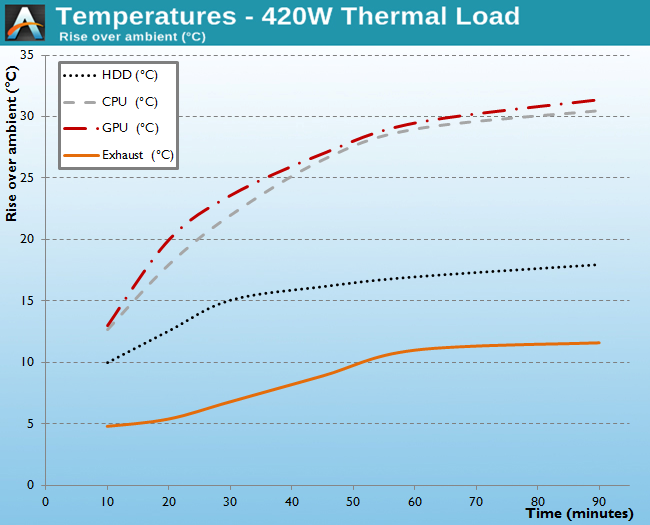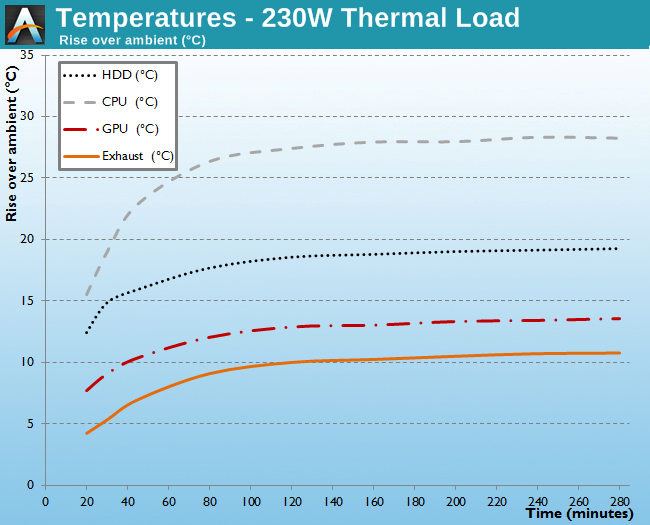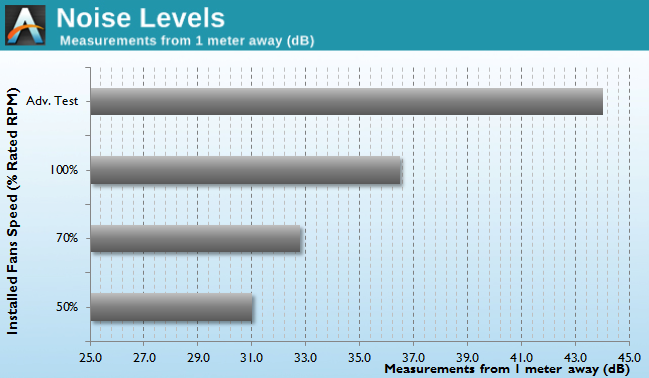Corsair Carbide Air 240 Case Review
by E. Fylladitakis on August 15, 2014 6:00 AM EST- Posted in
- Cases/Cooling/PSUs
- Corsair
- ATX
- Case
- Carbide
Test Setup
Professional testing requires the emulation of real-world situations but with repeatable results; thus, a perfectly controllable test setup and environment are required, especially for comparable results. Testing the thermal performance of any case with a typical real-world setup technically limits the comparability of the results to this setup alone, as an active system interacts with its environment and the change of a single component would alter myriads of variables. For our case reviews, we developed synthetic loads that emulate the thermal output of real systems, but these are passive, steady and quantifiable loads. This allows us to test the thermal capabilities of the case alone, as if it would have to deal with the entire thermal load by itself, regardless of what system an end user might install in it.
Laboratory data loggers are used to monitor the PT100 sensors and control the safety relays, which are fully accessible via our custom software. We have created three such loads, and we'll use the Micro-ATX load for this case. The Micro-ATX version simulates a 180W CPU, 40W VRM, 20W RAM, and 1 × 120W GPU card thermal load. Finally, two 3.5" HDD dummy loads have also been installed, with each of them converting 30W of electrical power to thermal. Note that the total load is generally more important than the individual elements, and the total thermal load of the Micro-ATX test setup is up to 420 Watts. As such, the thermal load is very high and only the best of cases will be able to handle it for more than a few minutes. For comparison purposes, we are also performing a test with a thermal load of 230W by reducing the CPU load to 90W, removing one disk load and using a low-profile, 50W version GFX load.
Thermal testing is performed with all of the case's stock fans operating at maximum speed. Standard noise testing has been performed with a background noise level of 30.4dB(A). Advanced noise testing is also being performed, in order to assess the ability of the case to dampen the noise of the components installed inside it. This includes the installation of two noise-generating sources (strong fans) inside the case, one positioned approximately over the first expansion slot and one over the CPU area, which generate ≈ 44.2 dB(A) when unobstructed. During the advanced noise test, all stock cooling options of the case are disabled.
Results and Discussion
As we expected from a case designed for ventilation, and despite its relatively compact size, the Carbide Air 240 displays exceptional thermal performance, significantly superior to that of the Mini-ITX Obsidian 250D. Although a direct comparison is not really possible, as the GPU load we use to test ATX cases is much higher, it would appear that the Carbide Air 240 has little to be jealous of Midi-ATX cases as well, delivering CPU and HDD temperatures that can easily rival cases such as the XFX Bravo 01 and Corsair's own Obsidian 450D.
The three stock cooling fans of the Carbide Air 240 are fairly weak, but that also has a positive effect on the acoustic performance of the case. With only the stock cooling fans installed, the Carbide Air 240 is a relatively quiet system, which can be made entirely quiet by simply connecting the fans onto the motherboard headers and leaving their speed control up to the BIOS. However, due to its design, the Carbide Air 240 cannot dampen the noise of the components installed inside it. Our testing revealed nearly zero noise-dampening capabilities, which is true of any case with so many openings on all sides.













63 Comments
View All Comments
know of fence - Sunday, August 17, 2014 - link
Do you think that at some point in the future you could arrive at the conclusion, that coolers which consume several times the power, with their failure prone mechanical pumps and fans which also require manual speed adjustment maybe aren't worth the trouble?kyuu - Tuesday, August 19, 2014 - link
Nope, because those "failure prone" pumps and fans are a much more efficient means of cooling. We're talking about desktop systems here, so it consuming a couple extra watts of power isn't really meaningful.I don't particularly care if you prefer air cooling. There are air coolers that work very well; I currently have a Zalman air cooler on my CPU, which replaced the Zalman air cooler on my previous CPU. But CLCs have very real advantages (while not being perfect, as no technology is), so I do take issue with people railing against is though choosing CLCs is somehow wrong.
I have no idea what you're talking about with the requiring manual adjustment thing.
kyuu - Tuesday, August 19, 2014 - link
railing against it as though***Damn lack of an edit button...
StrangerGuy - Saturday, August 16, 2014 - link
IMO this case is terribly designed. If Corsair are going to make a cube case, why not just copy the 250D design, make it fit a mATX mobo and 2x120mm radiator on the left side then be done with. Made even worse without a single 5.25 bay despite all the space at the right side.kyuu - Saturday, August 16, 2014 - link
"Motherboards of up to Micro-ATX size can be installed in the Carbide Air 240, but there is a catch: if you do install a Micro-ATX motherboard, you cannot install a liquid cooling radiator at the bottom of the case. You also cannot really install one at the top panel either, since the fan alone is just a hair away from the top of the motherboard. Therefore, you basically need to choose between two GPUs and a Micro-ATX motherboard, or two large liquid cooling radiators and a Mini-ITX motherboard (presumably with one GPU)."I checked out Corsair's specs, and it says that radiators are intended to be used on the bottom mounts and the *front*. The mounts at the top of the case are not intended for radiators at all, whether you're using mATX or mini-ITX. So you can, in fact, mount a single 240mm rad with an mATX (or, presumably, two 120mm rads) on the front of the case. Which makes me interested in this case.
kyuu - Saturday, August 16, 2014 - link
Though the one thing that would give me pause is if there's room for a thick (~50mm) push/pull radiator on the bottom. Looks like one might not fit due to the GPU, though a thinner one or one with a single fan might.Etern205 - Friday, August 29, 2014 - link
Never like this Corsair case, they want to make it like a cube. A cube is suppose to be compact and yet this is way too large. One problem I still don't get is the back and forth bickering about 5.25" drive bays. I still have a optical drive that I use occasionally, because it's the fastest method for me to install games as I prefer physical media as my bandwidth is consider slow compare to all the others, and other have bandwidth caps, so downloading a 15GB game is out of the question. Also 5.25" drives aren't just only for optical drives. It's not like the computer won't boot up or literally spit out the optical drive. You can use it for many other things like, LCD fan controllers, HDD bays, and many other stuffs. It's useful if you know what to do with it.kenoh - Sunday, August 31, 2014 - link
You can install 3-3.5" HDD's, but how many SSD's can you install?kenoh - Sunday, August 31, 2014 - link
Is it possible for this case to hold 4 SSD's, with all three HDD's installed? BTW, what PSU is used in this review?mekpro - Saturday, September 13, 2014 - link
That's Abit Motherboard !